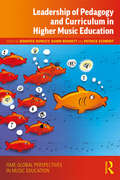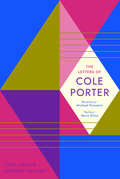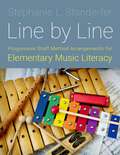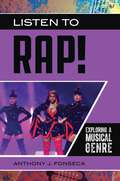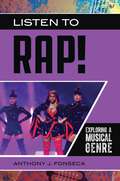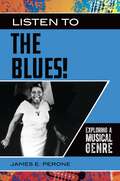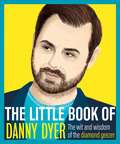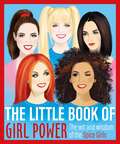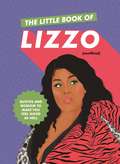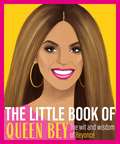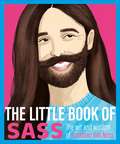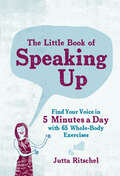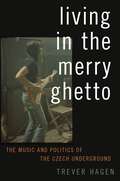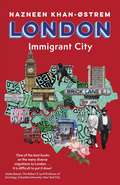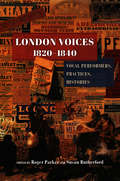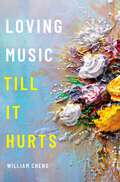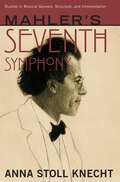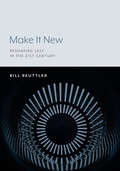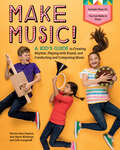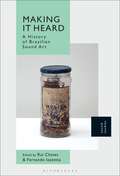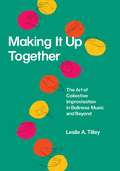- Table View
- List View
Leadership of Pedagogy and Curriculum in Higher Music Education (ISME Global Perspectives in Music Education Series)
by Jennifer Rowley Dawn Bennett Patrick SchmidtLeadership of Pedagogy and Curriculum in Higher Music Education is the second of a two-volume anthology dedicated to leadership and leadership development in higher music education. Fifteen authors write from multiple countries and contexts, exploring pedagogical and curricular leadership challenges and successes from around the globe. They draw attention to the dynamics of pedagogical approaches which encourage learners’ deep and agentic engagement, considering the sustainability and scope of such interventions while highlighting positive frameworks and approaches. As with its companion volume, Leadership of Pedagogy and Curriculum in Higher Music Education includes student commentary in which student contributors give concrete ideas and recommendations for facilitating and strengthening leadership development through practical and equitable strategies with students, communities and colleagues. The outcome is a collection of essays designed to offer student musicians, higher education teachers and institutional leaders theoretically informed and practical insights into the development and practice of leadership.
Leadership of Pedagogy and Curriculum in Higher Music Education (ISME Global Perspectives in Music Education Series)
by Jennifer Rowley Dawn Bennett Patrick SchmidtLeadership of Pedagogy and Curriculum in Higher Music Education is the second of a two-volume anthology dedicated to leadership and leadership development in higher music education. Fifteen authors write from multiple countries and contexts, exploring pedagogical and curricular leadership challenges and successes from around the globe. They draw attention to the dynamics of pedagogical approaches which encourage learners’ deep and agentic engagement, considering the sustainability and scope of such interventions while highlighting positive frameworks and approaches. As with its companion volume, Leadership of Pedagogy and Curriculum in Higher Music Education includes student commentary in which student contributors give concrete ideas and recommendations for facilitating and strengthening leadership development through practical and equitable strategies with students, communities and colleagues. The outcome is a collection of essays designed to offer student musicians, higher education teachers and institutional leaders theoretically informed and practical insights into the development and practice of leadership.
The Letters of Cole Porter
by Cole PorterThe first comprehensive collection of the letters of one of the most successful American songwriters of the twentieth century From Anything Goes to Kiss Me, Kate, Cole Porter left a lasting legacy of iconic songs including "You're the Top," "Love For Sale," and "Night and Day." Yet, alongside his professional success, Porter led an eclectic personal life which featured exuberant parties, scandalous affairs, and chronic health problems. This extensive collection of letters (most of which are published here for the first time) dates from the first decade of the twentieth century to the early 1960s and features correspondence with stars such as Irving Berlin, Ethel Merman, and Orson Welles, as well as his friends and lovers. Cliff Eisen and Dominic McHugh complement these letters with lively commentaries that draw together the loose threads of Porter’s life and highlight the distinctions between Porter’s public and private existence. This book reveals surprising insights into his attitudes toward Hollywood and Broadway, and toward money, love, and dazzling success.
LINE BY LINE C: Progressive Staff Method Arrangements for Elementary Music Literacy
by Stephanie L. StanderferIn Line by Line, author Stephanie L. Standerfer harnesses years of pedagogical expertise in a practical guide to promote music learning by experience rather than imitation and memorization. Using well-known songs and a variety of instrumental accompaniments for all skill levels, lesson plans encourage students to first learn music conceptually by internalizing the sound and feeling before learning musical symbols. The lesson plans are tailored for five to seven spiraled class periods and take every student into consideration by suggesting ways to address specific student needs for those who need more time to process.
Listen to Rap!: Exploring a Musical Genre (Exploring Musical Genres)
by Anthony J. FonsecaListen to Rap! Exploring a Musical Genre provides an overview of this kinetic and poetic musical genre for scholars of rap and curious novices alike.Listen to Rap! Exploring a Musical Genre discusses the 50 most influential, commercially successful, and important rappers, rap crews (bands), rap albums, and rap singles. Rap began as an American phenomenon, so the book's emphasis is on Americans, although it also includes information on Canadian, British, Indian, and African rappers and crews. Its organization makes information easily accessible for readers, and the emphasis on the sound of the music gives readers a new angle from which to appreciate the music. Unlike other titles in the series, this volume concentrates solely on rap music. Included in the book are rappers who range from the earliest practitioners of the genre to rappers who are redefining the genre today. A background section introduces the genre, while a legacy section shows how rap has cemented its place in the world. Additionally, another section shows the tremendous impact rap has had on popular culture.
Listen to Rap!: Exploring a Musical Genre (Exploring Musical Genres)
by Anthony J. FonsecaListen to Rap! Exploring a Musical Genre provides an overview of this kinetic and poetic musical genre for scholars of rap and curious novices alike.Listen to Rap! Exploring a Musical Genre discusses the 50 most influential, commercially successful, and important rappers, rap crews (bands), rap albums, and rap singles. Rap began as an American phenomenon, so the book's emphasis is on Americans, although it also includes information on Canadian, British, Indian, and African rappers and crews. Its organization makes information easily accessible for readers, and the emphasis on the sound of the music gives readers a new angle from which to appreciate the music. Unlike other titles in the series, this volume concentrates solely on rap music. Included in the book are rappers who range from the earliest practitioners of the genre to rappers who are redefining the genre today. A background section introduces the genre, while a legacy section shows how rap has cemented its place in the world. Additionally, another section shows the tremendous impact rap has had on popular culture.
Listen to the Blues!: Exploring a Musical Genre (Exploring Musical Genres)
by James E. PeroneListen to the Blues! Exploring A Musical Genre provides an overview of this distinctly American musical genre for fans of the blues and curious readers alike, with a focus on 50 must-hear artists, albums, and subgenres.Unlike other books on the blues, which tend to focus on musician biographies, Listen to the Blues! devotes time to the compositions, recordings, and musical legacies of blues musicians from the early 20th century to the present. Although the author references musical structure, harmony, form, and other musical concepts, the volume avoids technical language; therefore, it is a volume that should be of interest to the casual blues fan, to students of blues music and its history, and to more serious blues fans. The chapters on the impact of the blues on popular culture and the legacy of the blues also put the genre in a broader historical context than what is found in many books on the blues.The book opens with a background chapter that provides an overview of the history and structure of blues music. A substantial, encyclopedic chapter that focuses on 50 must-hear blues musicians follows, as does a chapter that explores the impact on popular culture of blues music and musicians and a chapter that focuses on the legacy of the genre. A bibliography rounds out the work.
Listen to the Blues!: Exploring a Musical Genre (Exploring Musical Genres)
by James E. PeroneListen to the Blues! Exploring A Musical Genre provides an overview of this distinctly American musical genre for fans of the blues and curious readers alike, with a focus on 50 must-hear artists, albums, and subgenres.Unlike other books on the blues, which tend to focus on musician biographies, Listen to the Blues! devotes time to the compositions, recordings, and musical legacies of blues musicians from the early 20th century to the present. Although the author references musical structure, harmony, form, and other musical concepts, the volume avoids technical language; therefore, it is a volume that should be of interest to the casual blues fan, to students of blues music and its history, and to more serious blues fans. The chapters on the impact of the blues on popular culture and the legacy of the blues also put the genre in a broader historical context than what is found in many books on the blues.The book opens with a background chapter that provides an overview of the history and structure of blues music. A substantial, encyclopedic chapter that focuses on 50 must-hear blues musicians follows, as does a chapter that explores the impact on popular culture of blues music and musicians and a chapter that focuses on the legacy of the genre. A bibliography rounds out the work.
The Little Book of Danny Dyer: The wit and wisdom of the diamond geezer
by Various'If the body is a temple, at the moment mine's a windowless shed.'Danny Dyer, actor and descendant of William the Conqueror, is the nation's favourite geezer well known for his cutting one-liners and amusing outbursts and, with them, he has captured all of our hearts. The Little Book of Danny Dyer is a collection of his most iconic quotes on politics, fitness, parenting and the important things in life.From Brexit to philosophising about how we wouldn't be able to eat sandwiches if we didn't have thumbs, The Little Book of Danny Dyer is the perfect gift for fans of this wise-cracking national treasure.
The Little Book of Girl Power: The Wit and Wisdom of the Spice Girls
by Various'When I came out of my mother's womb I screamed: "Girl Power!"' Ginger SpiceThe Spice Girls shaped the nineties. They taught us about girl power, union jack dresses, the power of leopard print clothes and how if we want to be our lover, you've got to get with our friends. The Little Book of Girl Power is a collection of the most iconic girl band's quotes on love, men, girl power and friendship.From Posh Spice's words on fashion to Sporty Spice on female friendships, The Little Book of Girl Power is the perfect gift for any Spice Girls fans in your life.
The Little Book of Lizzo
by Various'I don't think that loving yourself is a choice. I think that it's a decision that has to be made for survival' - LizzoLizzo is without doubt the self-love preaching, flute-playing, feel-good superstar the world needs rights now! Whether you stan her for her unforgettable lewks, body positivity or not giving a single f*ck about haters... this book of pocket wisdom is the perfect companion.The Little Book of Lizzo is a collection of the pop goddess's most iconic quotes, fiercest advice and boundary pushing wisdom, sure to leave you feeling good as hell.
The Little Book of Queen Bey: The Wit and Wisdom of Beyoncé
by Various'I will always believe in the strength we have as women.' As the queen of pop music since the glory days of Destiny's Child to her incredible solo career, Beyoncé is one of the most inspiring and powerful women in music. The Little Book of Queen Bey is a collection of the most iconic quotes from a woman who needs no introduction. When it comes to self-love, empowerment and sisterhood, Beyoncé has more wisdom than anybody. From how to be an independent woman to positive affirmations that will give you hope, The Little Book of Queen Bey is the perfect gift for fans of the goddess of pop. Prepare to be inspired.
The Little Book of Sass: The Wit and Wisdom of Jonathan Van Ness
by Various'You're strong, you're a Kelly Clarkson song, you got this.'Everything that comes out of Jonathan Van Ness's mouth is a gift from god. He's the man who taught us about hair, self-care and CON-FI-DONCE. The Little Book of Sass is a collection of the most iconic quotes from the sassiest man around on love, men, self-care and friendship.From the power of the heel to how to be the most supportive friend, The Little Book of Sass is the most shamazing gift for any JVN fans in your life.
The Little Book of Speaking Up: Find Your Voice in 5 Minutes a Day—with 65 Whole-Body Exercises
by Jutta RitschelA charming, down-to-earth compendium of easy vocal exercises to help us better express ourselves
LIVING IN THE MERRY GHETTO C: The Music and Politics of the Czech Underground
by Trever HagenLiving in the Merry Ghetto reframes how people use music to build resistance. Author Trever Hagen addresses the social context of illegal music-making in Czechoslovakia during state socialism. He tells the story of a group of rock'n'roll musicians who went underground after 1968, building a parallel world from where they could flourish: the Merry Ghetto. The book examines the case of the Czech Underground and the politics of their music and their way of life, paying close attention to the development of the ensemble The Plastic People of the Universe. Taking in multiple political transitions from the 1940s-2000s, the story focuses on non-official cultural practices such as listening to foreign radio broadcasts, seeking out copied cassette tapes, listening to banned LPs, growing long hair, attending clandestine concerts, smuggling albums via diplomats, recording in home-studios and being thrown in prison for any of these activities. Drawing on ethnographic interviews with Undergrounders, archival research and participant observation, Hagen shows how these practices shaped consciousness, informed bodies and promoted collective action, all of which contributed to an Underground identity.
London: Immigrant City
by Nazneen Khan-ØstremTRANSLATED BY ALISON McCULLOUGH'One of the best books on the many diverse migrations to London . . . revealing the extent to which the diversity of immigrant origins has had transformative effects - through food, music, diverse types of knowledge and so much more. The book is difficult to put it down'Saskia Sassen, The Robert S. Lynd Professor of Sociology, Columbia University, New York'The ultimate book about Great Britain's capital'Dagbladet'One of the best books of the year! . . . This is a book about what a city is and can be'AftenpostenIs there a street in London which does not contain a story from the Empire? Immigrants made London; and they keep remaking it in a thousand different ways. Nazneen Khan-Østrem has drawn a wonderful new map of a city that everyone thought they already knew. She travels around the city, meeting the very people who have created a truly unique metropolis, and shows how London's incredible development is directly attributable to the many different groups of immigrants who arrived after the Second World War, in part due to the Nationality Act of 1948. Her book reveals the historical, cultural and political changes within those communities which have fundamentally transformed the city, and which have rarely been considered alongside each other.Nazneen Khan-Østrem has a cosmopolitan background herself, being a British, Muslim, Asian woman, born in Nairobi and raised in the UK and Norway, which has helped her in unravelling the city's rich immigrant history and its constant ongoing evolution.Drawing on London's rich literature and its musical heritage, she has created an intricate portrait of a strikingly multi-faceted metropolis. Based on extensive research, particularly into aspects not generally covered in the wide array of existing books on the city, London manages to capture the city's enticing complexity and its ruthless vitality.This celebration of London's diverse immigrant communities is timely in the light of the societal fault lines exposed by the Covid-19 pandemic and Brexit. It is a sensitive and insightful book that has a great deal to say to Londoners as well as to Britain as a whole.
London Voices, 1820–1840: Vocal Performers, Practices, Histories
London, 1820. The British capital is a metropolis that overwhelms dwellers and visitors alike with constant exposure to all kinds of sensory stimulation. Over the next two decades, the city’s tumult will reach new heights: as population expansion places different classes in dangerous proximity and ideas of political and social reform linger in the air, London begins to undergo enormous infrastructure change that will alter it forever. It is the London of this period that editors Roger Parker and Susan Rutherford pinpoint in this book, which chooses one broad musical category—voice—and engages with it through essays on music of the streets, theaters, opera houses, and concert halls; on the raising of voices in religious and sociopolitical contexts; and on the perception of voice in literary works and scientific experiments with acoustics. Emphasizing human subjects, this focus on voice allows the authors to explore the multifaceted issues that shaped London, from the anxiety surrounding the city’s importance in the musical world at large to the changing vocal imaginations that permeated the epoch. Capturing the breadth of sonic stimulations and cultures available—and sometimes unavoidable—to residents at the time, London Voices, 1820–1840 sheds new light on music in Britain and the richness of London culture during this period.
London Voices, 1820–1840: Vocal Performers, Practices, Histories
by Roger Parker Susan RutherfordLondon, 1820. The British capital is a metropolis that overwhelms dwellers and visitors alike with constant exposure to all kinds of sensory stimulation. Over the next two decades, the city’s tumult will reach new heights: as population expansion places different classes in dangerous proximity and ideas of political and social reform linger in the air, London begins to undergo enormous infrastructure change that will alter it forever. It is the London of this period that editors Roger Parker and Susan Rutherford pinpoint in this book, which chooses one broad musical category—voice—and engages with it through essays on music of the streets, theaters, opera houses, and concert halls; on the raising of voices in religious and sociopolitical contexts; and on the perception of voice in literary works and scientific experiments with acoustics. Emphasizing human subjects, this focus on voice allows the authors to explore the multifaceted issues that shaped London, from the anxiety surrounding the city’s importance in the musical world at large to the changing vocal imaginations that permeated the epoch. Capturing the breadth of sonic stimulations and cultures available—and sometimes unavoidable—to residents at the time, London Voices, 1820–1840 sheds new light on music in Britain and the richness of London culture during this period.
London Voices, 1820–1840: Vocal Performers, Practices, Histories
by Roger Parker Susan RutherfordLondon, 1820. The British capital is a metropolis that overwhelms dwellers and visitors alike with constant exposure to all kinds of sensory stimulation. Over the next two decades, the city’s tumult will reach new heights: as population expansion places different classes in dangerous proximity and ideas of political and social reform linger in the air, London begins to undergo enormous infrastructure change that will alter it forever. It is the London of this period that editors Roger Parker and Susan Rutherford pinpoint in this book, which chooses one broad musical category—voice—and engages with it through essays on music of the streets, theaters, opera houses, and concert halls; on the raising of voices in religious and sociopolitical contexts; and on the perception of voice in literary works and scientific experiments with acoustics. Emphasizing human subjects, this focus on voice allows the authors to explore the multifaceted issues that shaped London, from the anxiety surrounding the city’s importance in the musical world at large to the changing vocal imaginations that permeated the epoch. Capturing the breadth of sonic stimulations and cultures available—and sometimes unavoidable—to residents at the time, London Voices, 1820–1840 sheds new light on music in Britain and the richness of London culture during this period.
Loving Music Till It Hurts
by William ChengCan music feel pain? Do songs possess dignity? Do symphonies have rights? Of course not, you might say. Yet think of how we anthropomorphize music, not least when we believe it has been somehow mistreated. A singer butchered or mangled the "Star-Spangled Banner" at the Super Bowl. An underrehearsed cover band made a mockery of Led Zeppelin's classics. An orchestra didn't quite do justice to Mozart's Requiem. Such lively language upholds music as a sentient companion susceptible to injury and in need of fierce protection. There's nothing wrong with the human instinct to safeguard beloved music . . . except, perhaps, when this instinct leads us to hurt or neglect fellow human beings in turn: say, by heaping outsized shame upon those who seem to do music wrong; or by rushing to defend a conductor's beautiful recordings while failing to defend the multiple victims who have accused this maestro of sexual assault. Loving Music Till It Hurts is a capacious exploration of how people's head-over-heels attachments to music can variously align or conflict with agendas of social justice. How do we respond when loving music and loving people appear to clash?
MAHLER'S SEVENTH SYMPHONY SMGS C (Studies in Musical Genesis, Structure, and Interpretation)
by Anna Stoll KnechtGustav Mahler's Seventh Symphony stands out as one of the most provocative symphonic statements of the early twentieth century. Throughout its performance history, it has often been heard as "existing in the shadow" of the Sixth Symphony or as "too reminiscent" of Richard Wagner's opera Die Meistersinger von Nürnberg. Anna Stoll Knecht's Mahler's Seventh Symphony offers a new interpretation of the Seventh based on a detailed study of Mahler's compositional materials and a close reading of the finished work. With a focus on sketches previously considered as "discarded," Stoll Knecht exposes unexpected connections between the Seventh and both the Sixth and Meistersinger, confirming that Mahler's compositional project was firmly grounded in a dialogue with works from the past. This referential aspect acts as an important interpretive key to the work, enabling the first thorough analysis of the sketches and drafts for the Seventh, and shedding light on its complex compositional history. Considering each movement of the symphony through a double perspective, genetic and analytic, Stoll Knecht demonstrates how sketch studies and analytical approaches can interact with each other. Mahler's Seventh Symphony exposes new facets of Mahler's musical humor and leads us to rethink much-debated issues concerning the composer's cultural identity, revealing the Seventh's pivotal role within his output.
Make It New: Reshaping Jazz in the 21st Century
by Bill BeuttlerAs jazz enters its second century it is reasserting itself as dynamic and relevant. Boston Globe jazz writer and Emerson College professor Bill Beuttler reveals new ways in which jazz is engaging with society through the vivid biographies and music of Jason Moran, Vijay Iyer, Rudresh Mahanthappa, The Bad Plus, Miguel Zenón, Anat Cohen, Robert Glasper, and Esperanza Spalding. These musicians are freely incorporating other genres of music into jazz—from classical (both western and Indian) to popular (hip-hop, R&B, rock, bluegrass, klezmer, Brazilian choro)—and other art forms as well (literature, film, photography, and other visual arts). This new generation of jazz is increasingly more international and is becoming more open to women as instrumentalists and bandleaders. Contemporary jazz is reasserting itself as a force for social change, prompted by developments such as the Black Lives Matter, #MeToo movements, and the election of Donald Trump.
Make Music!: A Kid's Guide to Creating Rhythm, Playing with Sound, and Conducting and Composing Music
by Norma Jean Haynes Ann Sayre Wiseman John LangstaffThis book puts the &“play&” back in music with inventive ideas for simple homemade instruments and creative instructions for orchestrating sound and rhythm with delightful results — no prior musical experience required!
Making It Heard: A History of Brazilian Sound Art
by Rui Chaves Fernando IazzettaFrom the mid-20th century to present, the Brazilian art, literature, and music scene have been witness to a wealth of creative approaches involving sound. This is the backdrop for Making It Heard: A History of Brazilian Sound Art, a volume that offers an overview of local artists working with performance, experimental vinyl production, sound installation, sculpture, mail art, field recording, and sound mapping. It criticizes universal approaches to art and music historiography that fail to recognize local idiosyncrasies, and creates a local rationale and discourse. Through this approach, Chaves and Iazzetta enable students, researchers, and artists to discover and acknowledge work produced outside of a standard Anglo-European framework.
Making It Up Together: The Art of Collective Improvisation in Balinese Music and Beyond (Chicago Studies in Ethnomusicology)
by Leslie A. TilleyMost studies of musical improvisation focus on individual musicians. But that is not the whole story. From jazz to flamenco, Shona mbira to Javanese gamelan, improvised practices thrive on group creativity, relying on the close interaction of multiple simultaneously improvising performers. In Making It Up Together, Leslie A. Tilley explores the practice of collective musical improvisation cross-culturally, making a case for placing collectivity at the center of improvisation discourse and advocating ethnographically informed music analysis as a powerful tool for investigating improvisational processes. Through two contrasting Balinese case studies—of the reyong gong chime’s melodic norot practice and the interlocking drumming tradition kendang arja—Tilley proposes and tests analytical frameworks for examining collectively improvised performance. At the micro-level, Tilley’s analyses offer insight into the note-by-note decisions of improvising performers; at the macro-level, they illuminate larger musical, discursive, structural, and cultural factors shaping those decisions. This multi-tiered inquiry reveals that unpacking how performers play and imagine as a collective is crucial to understanding improvisation and demonstrates how music analysis can elucidate these complex musical and interactional relationships. Highlighting connections with diverse genres from various music cultures, Tilley’s examinations of collective improvisation also suggest rich potential for cross-genre exploration. The surrounding discussions point to larger theories of communication and interaction, creativity and cognition that will be of interest to a range of readers—from ethnomusicologists and music theorists to cognitive psychologists, jazz studies scholars, and improvising performers. Setting new parameters for the study of improvisation, Making It Up Together opens up fresh possibilities for understanding the creative process, in music and beyond.
